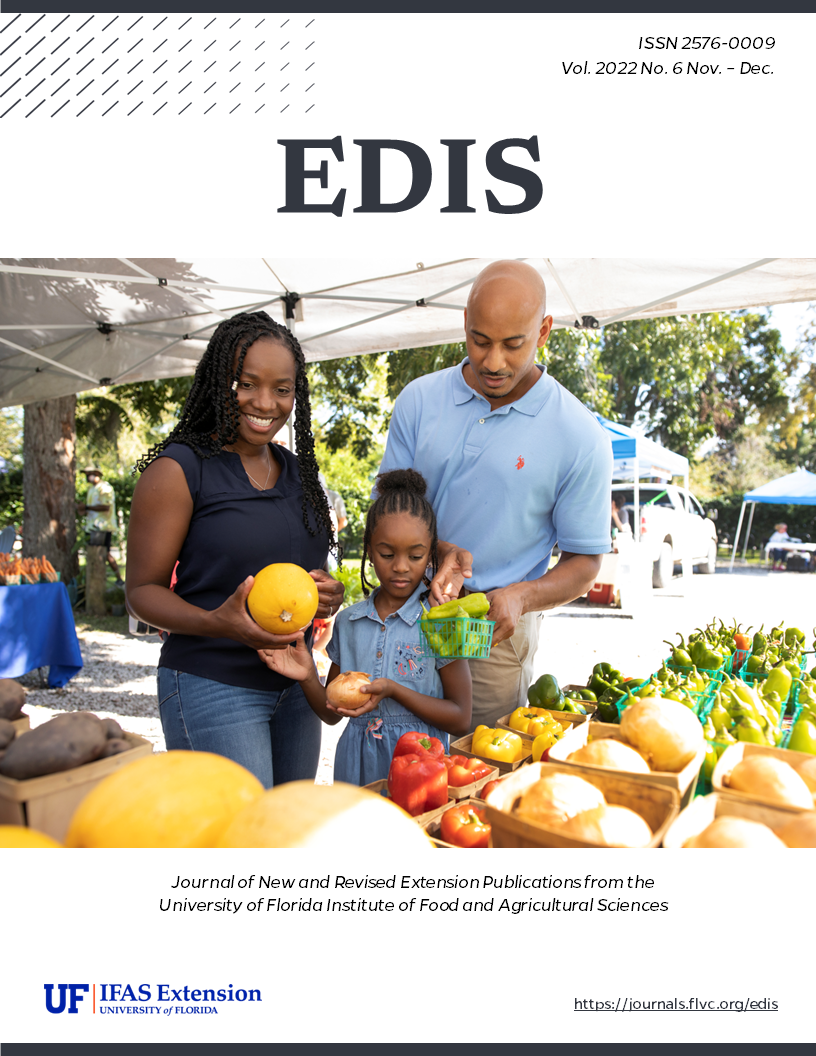Resumen
This new 10-page publication of the UF/IFAS Environmental Horticulture Department is intended to inform home gardeners, pest management professionals, and other plant enthusiasts of some of the most common poisonous invasive plants or weed species common in home landscapes in Florida, with particular focus on species that could potentially cause harm if ingested. Written by Yuvraj Khamare and Chris Marble.
https://edis.ifas.ufl.edu/ep631
Citas
Basch, E., S. Gabardi, and C. Ulbricht. 2003. Bitter melon (Momordica charantia): A review of efficacy and safety. Am. J. Health Syst. Pharm. 60:356-359. https://doi.org/10.3382/ps.0541215 Accessed June 11, 2022.
Barnett, B.D., 1975. Toxicity of pokeberries (fruit of Phytolacca americana Large) for turkey poults. Poultry Science, 54(4), pp.1215-1217. https://doi.org/10.3382/ps.0541215
Coladoanto, M. 1991. Parthenocissus quinquefolia.
U.S. Department of Agriculture, Forest Service, Rocky Mountain Research Station, Fire Sciences Laboratory. www.fs.fed.us/database/feis/plants/vine/parqui/all.html. Accessed June 9, 2022.
Cope, R.B., 2005. Allium species poisoning in dogs and cats. Veterinary Medicine-Bonner Springs Then Edwardsville, 100(8), 562.
Colorado State University (CSU). 2021. Guide to Poisonous Plants. https://csuvth.colostate.edu/poisonous_plants/Plants/Details/141. Accessed June 9, 2022.
Englberger K, 2009. Invasive weeds of Pohnpei: A guide for identification and public awareness. Kolonia, Federated States of Micronesia: Conservation Society of Pohnpei, 29 pp.
Enloe, S.F, and Langeland. K. 2021. Invasive plants in natural areas: Air potato (Dioscorea bulbifera). SS-AGR-164. Gainesville: University of Florida Institute of Food and Agricultural Sciences. Accessed 8 March 2022. https://doi.org/10.32473/edis-ag112-2021.
Everest, J. W., T. A. Powe Jr., and J. D. Freeman. 2010. Poisonous plants of the southeastern United States. Alabama Cooperative Extension System [ACES] Publications, Auburn, Alabama, USA.
Gardner, D.R. and F. Riet-Correa. 2011. Analysis of the toxic amino acid indospicine by liquid chromatography-tandem mass spectrometry. Intl. J. Poisonous Plant Res. 1:20-27.
Guan, XR., Zhu, L., Xiao, ZG. et al. Bioactivity, toxicity and detoxification assessment of Dioscorea bulbifera L.: a comprehensive review. Phytochem Rev 16, 573–601 (2017). https://doi.org/10.1007/s11101-017-9505-5
Holm L.G., Doll, J., Holm, E., Pancho J.V., Herberger J.P. 1997. World Weeds: Natural Histories and Distribution. New York, USA: John Wiley & Sons Inc
Kayalvizhi, K., Kumar, A.R., Sankari, A. and Anand, M., 2020. Poisonous Ornamental Plants. Biotica Research Today, 2(5 Spl.),392-399. https://biospub.com/index.php/biorestoday/article/view/204. Accessed: June 14, 2022.
Kingsbury, J.M., 1964. Poisonous plants of the United States and Canada. Soil Science, 98(5), 349. https://doi.org/10.1097/00010694-196411000-00022
Kong, C. H., Xuan, T. D., Khanh, T. D., Tran, H. D., & Trung, N. T. 2019. Allelochemicals and signaling chemicals in plants. Molecules, 24(15), 2737. https://doi.org/10.3390/molecules24152737.
Milner, S.E., Brunton, N.P., Jones, P.W., O’Brien, N.M., Collins, S.G. and Maguire, A.R., 2011. Bioactivities of glycoalkaloids and their aglycones from Solanum species. Journal of agricultural and food chemistry, 59(8), 3454-3484. https://doi.org/10.1021/jf200439q
Phua, D.H., W.J. Tsai, J. Ger, J.F. Deng and C.C. Yang. 2008. Human Melia azedarach poisoning, Clinical Toxicology, 46:10, 1067-1070 https://doi.org/10.1080/15563650802310929
Stephens, J. M. 2018. Pokeweed—Phytolacca americana L. HS648. Gainesville: University of Florida Institute of Food and Agricultural Sciences. Accessed 5 April 2022. https://edis.ifas.ufl.edu/publication/MV115
Trull, S. n.d. Plant of the week: common sneezeweed (Helenium autumnale L. var. autumnale). U.S. Forest Service. Accessed 6 July 2022. https://www.fs.fed.us/wildflowers/plant-of-the-week/helenium_autumnale_autumnale.shtml.
USDA, NRCS. 2022. The PLANTS Database (http://plants.usda.gov, 04/14/2022). National Plant Data Team, Greensboro, NC, USA.
Waggy, Melissa, A. 2009. Melia azedarach. U.S. Department of Agriculture, Forest Service, Rocky Mountain Research Station. Available: https://www.fs.fed.us/database/feis/plants/tree/melaze/all.html. Accessed June 9, 2022.
Walters, T.W. and D.S. Decker-Walters. 1988. Balsam-pear (Momordica charantia, Cucurbitaceae). Economic Botany 42:286-288.
Wunderlin, R. P., B. F. Hansen, A. R. Franck, and F. B. Essig. 2022. Atlas of Florida Plants (http://florida.plantatlas.usf.edu/). [S. M. Landry and K. N. Campbell (application development), USF Water Institute.] Institute for Systematic Botany, University of South Florida, Tampa. Accessed March 25, 2022.

